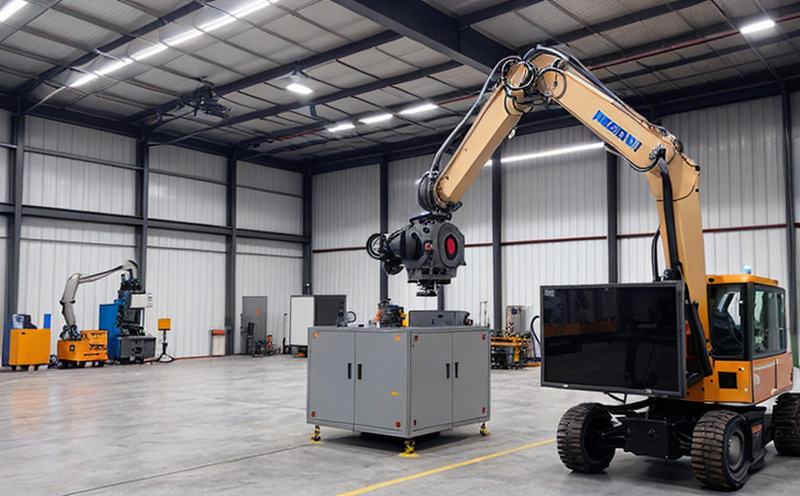ASTM D638 Tensile Properties of Robotic Structural Plastics
The ASTM D638 standard test method is widely recognized for its ability to accurately measure the tensile properties of plastics, including those used in robotics. This service ensures that critical components meet the necessary strength requirements needed for industrial and manufacturing robotic systems.
In the context of robotics and artificial intelligence (AI) systems testing, particularly within industrial and manufacturing robotics, it is crucial to ensure that structural materials exhibit adequate tensile properties to withstand various operational stresses during use. These stresses can include but are not limited to mechanical loading from moving parts, environmental factors like temperature fluctuations, and potential exposure to harsh chemicals.
The ASTM D638 test provides a standardized approach for determining the tensile strength (σu) and elongation at break (%) of materials used in robotic applications. Compliance with this standard helps manufacturers verify that their products can meet stringent safety regulations while maintaining reliability under real-world conditions.
To perform ASTM D638 testing, samples are typically cut from larger pieces of the plastic material being evaluated. Specimens undergo conditioning according to specified temperature and humidity levels before undergoing tensile testing in a controlled environment. The test involves applying force until failure occurs, during which continuous data collection allows for precise determination of peak load (Pmax) and strain at break.
The results from ASTM D638 tests are essential inputs when designing robotic systems capable of operating safely within industrial settings. Engineers rely on these data points to optimize component design, ensuring both performance capabilities and compliance with relevant standards such as ISO 10276-1 or EN 954.
A more detailed breakdown reveals that the tensile test setup consists of a testing machine equipped with grips capable of holding specimen samples securely throughout the procedure. Specimens are aligned along their longitudinal axes so they stretch uniformly during loading. Software integrated into the instrument records all pertinent measurements automatically, including displacement and force applied over time.
Upon completion of the ASTM D638 test, a comprehensive report is generated detailing the tensile properties of each tested sample. This document includes calculated values for tensile strength (σu) and elongation at break (%), along with graphical representations showing stress-strain curves derived from collected data.
Compliance with ASTM D638 ensures that robotic structural plastics meet stringent quality control standards, thereby enhancing overall product reliability and safety. By adhering to this testing protocol, manufacturers can demonstrate adherence to international best practices and contribute positively towards industry-wide standards development efforts.
Why Choose This Test
- Ensures compliance with ASTM D638 standard for tensile property determination of plastics used in robotic applications.
- Provides critical data on tensile strength and elongation at break essential for design optimization.
- Supports safety regulations and enhances product reliability through rigorous quality assurance processes.
The ASTM D638 test is particularly valuable because it offers a reliable method of assessing the mechanical integrity of materials used in robotic systems. By ensuring that these components meet specified strength criteria, engineers can design more efficient and safer machines capable of performing complex tasks reliably over extended periods.
This standardized testing approach also enables manufacturers to compare their products against industry benchmarks easily, facilitating better decision-making regarding material selection and process optimization. Moreover, compliance with ASTM D638 helps companies achieve higher levels of customer satisfaction by delivering robust solutions that stand up to rigorous operational demands.
Customer Impact and Satisfaction
The use of ASTM D638 tensile testing in robotics significantly impacts customers by providing them with reliable, high-performance robotic systems. These tests ensure that the structural plastics used in robots meet stringent quality standards, leading to increased customer satisfaction through enhanced product reliability.
- Enhanced Robustness: By ensuring robustness of materials via ASTM D638 testing, customers can expect longer-lasting and more dependable robotic equipment.
- Better Safety: Meeting the requirements set by this standard contributes directly to improved safety features in robots used in industrial environments.
- Informed Decision-Making: With accurate data provided through these tests, customers make informed choices about selecting suitable materials for their projects.
Moreover, compliance with ASTM D638 fosters trust between manufacturers and end-users by demonstrating adherence to recognized quality benchmarks. This transparency helps build stronger relationships based on mutual respect and shared goals towards excellence in engineering practices.
In summary, the application of ASTM D638 tensile testing plays a pivotal role in enhancing customer satisfaction through improved product performance and safety measures. It serves as an indispensable tool for manufacturers aiming to deliver superior robotic systems that meet global standards.
Environmental and Sustainability Contributions
The application of ASTM D638 tensile testing in robotics also contributes positively towards environmental sustainability. By ensuring robustness, reliability, and safety in robotic systems through rigorous quality control processes, manufacturers can reduce waste by extending the lifespan of their products.
- Reduced Waste: Longer-lasting components mean fewer replacements, which translates into less electronic waste entering landfills over time.
- Eco-Friendly Design: Compliance with ASTM D638 encourages designers to choose sustainable materials that are easier to recycle or reuse at end-of-life stages.
Furthermore, the accurate data provided by these tests enables engineers to refine designs continuously, striving for greater efficiency and reduced energy consumption in robotic operations. This commitment to sustainability not only benefits the environment but also enhances corporate reputation among environmentally conscious stakeholders.
In conclusion, the implementation of ASTM D638 tensile testing aligns with broader goals related to environmental stewardship and sustainable development practices within the robotics industry. It promotes responsible resource use while fostering innovation aimed at creating greener technologies for future generations.





